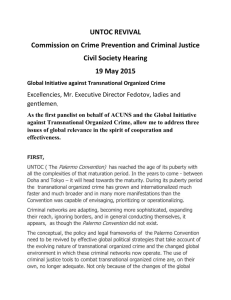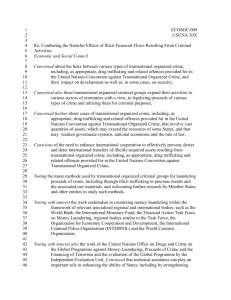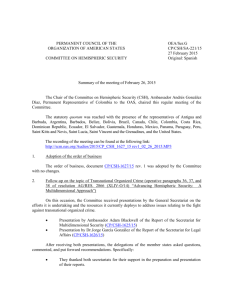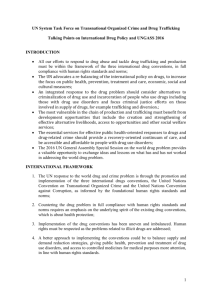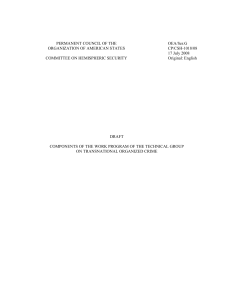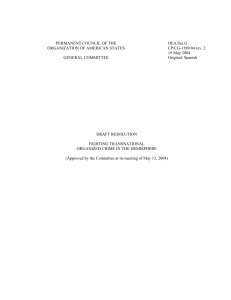OEA/Ser - Organization of American States
advertisement
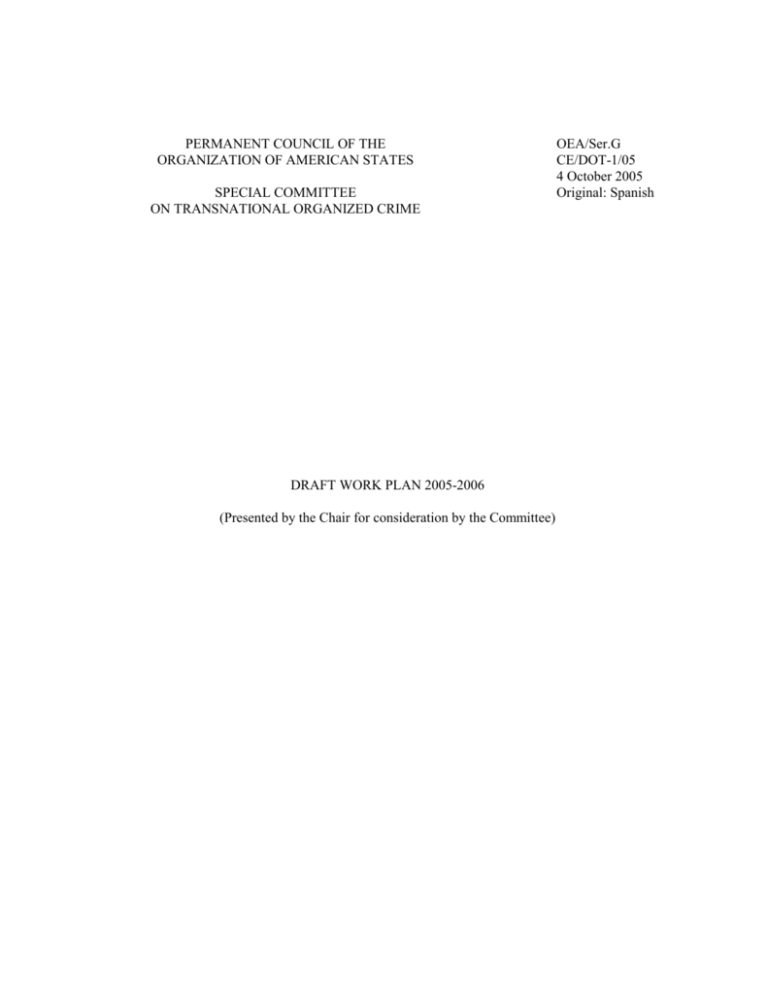
PERMANENT COUNCIL OF THE ORGANIZATION OF AMERICAN STATES SPECIAL COMMITTEE ON TRANSNATIONAL ORGANIZED CRIME DRAFT WORK PLAN 2005-2006 (Presented by the Chair for consideration by the Committee) OEA/Ser.G CE/DOT-1/05 4 October 2005 Original: Spanish DRAFT WORK PLAN 2005-2006 (Presented by the Chair for consideration by the Committee) INTRODUCTION In recent years, the topic of transnational organized crime has become more prominent on the inter-American agenda. This is due first to an effort by member states to develop an integral, multidimensional, and multidisciplinary approach to regional security, which incorporates “traditional” and “new threats, concerns, and challenges to the Hemisphere’s security. Second, it is due to the need to find appropriate responses to the transnational criminal gangs operating in all states of the Hemisphere, which undermine our states’ capacity to counter their criminal activities; and, third to the enormous international effort to harmonize criminal laws and facilitate legal assistance and cooperation through the adoption of the United Nations Convention against Transnational Organized Crime and the three supplementary protocols thereto. After years of study and negotiations, this Convention codifies common terms and concepts adopted by the international community to prevent impunity and strengthen mutual cooperation and technical and legal assistance. In this context, member states’ efforts against transnational organized crime may be placed in two major categories. On the one hand, as a result of the obligations assumed under international conventions, member states are committed to the development of domestic criminal legislation that is compatible with that of other countries, criminalizing certain offenses with similar characteristics. On the other, the member states are seeking to strengthen a system for collaboration among authorities of the various states in order to regulate such operations as the exchange of evidence, joint operations, and extradition, with a view to punishing and preventing this criminal conduct. Cooperation among states parties to the conventions and among OAS member states can obviously be strengthened and broadened as required by actual circumstances and the challenge posed by transnational organized crime. The Organization’s scope of action in this regard is defined by the Summits of the Americas, the Declaration on Security in the Americas, and in particular resolutions AG/RES. 2026 (XXXIVO/04) and AG/RES. 2116 (XXXV-O/05), “Fighting Transnational Organized Crime in the Hemisphere.” The Summits have recognized that concerted action must be taken against transnational organized crime in order to consolidate justice, the rule of law, and the security of individuals. According to the Declaration on Security in the Americas, adopted in Mexico City on October 28, 2003, terrorism, transnational organized crime, the global drug problem, corruption, asset laundering, illicit trafficking in weapons, and the connections among them are part of the new threats, concerns, and other challenges of a diverse nature to the security of the states of the Hemisphere. The General Assembly adopted the aforementioned resolutions, AG/RES. 2026 (XXXIV-O/04) and AG/RES. 2116 (XXXV-O/05)--the first in Quito at a plenary session on June 8, 2004, and the second in Fort Lauderdale at a plenary session on June 7, 2005. Resolution AG/RES. 2116 (XXXV-O/05) resolves, among other things, To invite states to adopt and implement the Palermo Convention and the three supplementary Protocols thereto; -2- To strengthen cooperation on the matter; That the topic shall continue to be considered by the entities that have been doing so, within their respective spheres of competence; To establish the Special Committee on Transnational Organized Crime to prepare a draft hemispheric plan of action and to follow up on the activities of the Organization and its organs, agencies, and entities; and To take into account the “Conclusions and Recommendations of the Meeting of Government Experts to Consider the Advisability of Developing a Hemispheric Plan of Action against Transnational Organized Crime.” These are the clear objectives that the Committee will have to pursue as it begins its work. For its part, the General Secretariat, acting pursuant to the mandate in resolution AG/RES. 2116 (XXXV-O/05), must consolidate its restructuring in the area of multidimensional security, by serving as secretariat to the Special Committee in addition to developing a mechanism for coordinating the efforts of the organs, agencies, entities, and mechanisms currently dealing with topics related to the prevention of and the fight against transnational organized crime, in order to prevent duplication and optimize the use of institutional resources. WORK PLAN Accordingly, a first concrete step or outcome of the work of the Special Committee will be the preparation of a Draft Hemispheric Plan of Action against Transnational Organized Crime, based on a multidimensional approach to security and on the Palermo Convention and the Protocols thereto, for consideration by the Sixth Meeting of Ministers of Justice or of Ministers or Attorneys General of the Americas (REMJA-VI) and possible adoption by the General Assembly at its thirty-sixth regular session. As its name indicates, the Plan of Action will have to take the basic legal framework mentioned above into account and propose concrete measures to step up and facilitate cooperation among our governments, all within the serious budget constraints we are well aware of. The Special Committee will therefore have to focus on identifying those measures rather than on reopening discussion on topics and definitions that have been the subject of prior agreements. For example, the Convention establishes definitions arrived at after years of study and negotiation. The Special Committee would be wasting its valuable and limited time if it got bogged down in an exhaustive discussion on the matter. -3- To prevent this and enable the Special Committee to achieve its objective, the following Work Plan is proposed: A. Thematic approach I suggest that, in considering each of the manifestations of organized crime, the Special Committee follow the method established in the Palermo Convention, with the exception of the sections of that instrument that deal with definitions and with technical procedures for its implementation. Then, for each manifestation of transnational organized crime, the Special Committee would identify measures to help member states: (1) Establish as criminal offenses certain types of conduct envisaged in the Convention and the supplementary Protocols thereto, placing special emphasis on the development of laws and regulations in each state; (2) Improve national capacities by developing specific control measures and special techniques for investigation, training, joint investigation, and information exchange; (3) Promote international cooperation activities through existing OAS mechanisms (bilateral agreements, mutual legal assistance, recovery and/or division of assets, mechanisms for institutional cooperation, technical assistance, information exchange, dissemination of best practices, special investigation techniques, confidencebuilding, extradition, mutual judicial assistance, etc.); and (4) Promote the use of preventive policies and measures.1/ The Special Committee will identify the measures that the OAS can take to accelerate implementation of each of these areas of work and will incorporate those measures into the Hemispheric Plan of Action. B. Institutional methodology To conduct the necessary analysis and identify measures that can be incorporated into the Hemispheric Plan of Action, I propose that the Special Committee meet once a week to consider each of the manifestations of transnational organized crime, through panels of experts and discussion among delegates on the Committee. Accordingly, every state will be able share its experience and provide support in its respective areas of competence, together with experts from the various bodies involved in each topic, as well as with other international organizations working on the topic, 1. All of the criminal offenses to which the OAS has attached priority are included in the Palermo Convention, either specifically or as part of the “serious crimes” category, in other works, those punished by a minimum prison term. They could include, inter alia, illicit drug trafficking, money laundering, illicit arms trafficking, trafficking in persons, smuggling of migrants, cybercrime, juvenile criminal gangs, kidnapping, corruption, and connections between terrorism and these manifestations. -4- including the United Nations. The Chair will ask the General Secretariat to provide it with as much assistance as possible in carrying out the mission entrusted to it. After each item has been considered and discussed, the Chair may wish to present conclusions concerning future treatment of the subject as well as concrete points for possible inclusion in the Draft Hemispheric Plan of Action against Transnational Organized Crime. Some of the agencies and entities to be invited to participate in this process of joint reflection are those cited in the corresponding resolutions, including the Inter-American Drug Abuse Control Commission (CICAD), the Consultative Committee of the Inter-American Convention against the Illicit Manufacturing of and Trafficking in Firearms, Ammunition, Explosives, and Other Related Materials (CIFTA), the Inter-American Commission of Women (CIM), the Inter-American Children's Institute (IIN), the Hemispheric Information Exchange Network for Mutual Legal Assistance in Criminal Matters, the Meeting of Ministers of Justice or of Ministers or Attorneys General of the Americas (REMJA), the Follow-up Mechanism for the Implementation of the Inter-American Convention against Corruption (MESICIC), and the Inter-American Committee against Terrorism (CICTE). After consideration of all of the points mentioned, the Chair will present a Draft Hemispheric Plan of Action against Transnational Organized Crime, which may be submitted to capitals for consideration and negotiation prior to REMJA-VI. TOPICS OF THE HEMISPHERIC PLAN OF ACTION AGAINST TRANSNATIONAL ORGANIZED CRIME ISSUES TO BE EXAMINED FORTHE PLAN MANIFESTATIONS OF TRANSNATIONAL ORGANIZED CRIME Drugs Trafficking in persons Illicit arms trafficking Smuggling of migrants Criminal gangs Money laundering Corruption Kidnapping Cybercrime Connections with terrorism Other LEGISLATIVE DEVELOPMENT IMPROVEMENT OF NATIONAL CAPACITIES INTERNATIONAL COOPERATION MEASURES DEVELOPMENT OF PREVENTION POLICIES -5- We repeat that the topics already addressed by other OAS agencies and entities will be considered from the viewpoint of transnational organized crime and for inclusion in the Hemispheric Plan of Action, without this entailing any change in the areas of responsibility of those agencies or entities. C. Budget Given the budgetary constraints facing the Organization and the corresponding need to limit spending, I think that the most responsible way to carry out our mandates is for delegations and experts to attend each of the Committee meetings and to be punctual, thus ensuring that every meeting will produce results. Holding weekly meetings would appear to be the best approach to addressing the tasks we have been assigned. D. Schedule As noted earlier, resolution AG/RES. 2116 (XXXV-O/05) requested the Permanent Council to present the Draft Hemispheric Plan of Action against Transnational Organized Crime to the Sixth Meeting of Ministers of Justice or of Ministers or Attorneys General of the Americas (REMJA-VI) for consideration and for possible adoption by the General Assembly at its thirty-sixth regular session. Resolution AG/RES. 2068 (XXXV-O/05) decided to convene the Sixth Meeting of Ministers of Justice or of Ministers or Attorneys General of the Americas (REMJA-VI), to be held in 2006. A precise date has not yet been set. Therefore, the Special Committee has at least until the end of 2005 to do its work and probably at least a few months in 2006 to continue it. Subject to change once the date for REMJA-VI has been set, I suggest the following meeting schedule for the Special Committee: -6- MANIFESTATIONS OF ORGANIZED CRIME Initiation of work, election of the vice chair, consideration of the plan SPECIAL COMMITTEE MEETINGS Wednesday, October 19 10:00 a.m. - 1:00 p.m. Drugs/money laundering Wednesday, October 26 10:00 a.m. - 1:00 p.m. Corruption Wednesday, November 2 10:00 a.m. - 1:00 p.m. Illicit arms trafficking Wednesday, November 9 10:00 p.m. - 1:00 p.m. Cybercrime Wednesday, November 16 10:00 a.m. - 1:00 p.m. Criminal gangs Wednesday, November 23 10:00 a.m. - 1:00 p.m. Smuggling of migrants Wednesday, November 30 10:00 a.m. - 1:00 p.m. Kidnapping Wednesday, December 7 10:00 a.m. - 1:00 p.m. Trafficking in persons Wednesday, December 14 10:00 a.m. - 1:00 p.m. Connections with terrorism Wednesday, January 11 10:00 a.m. - 1:00 p.m. At the last meeting of 2005, a schedule will be presented for 2006. Negotiations on the Draft Plan of Action to be submitted to REMJA-VI will begin in January. I hope that this draft plan will be helpful to the members of the Special Committee, who are encouraged to make any suggestions for its improvement prior to the start of the meetings indicated. Any comments are welcome. Ambassador Jorge Chen Permanent Representative of Mexico Chair of the Special Committee on Transnational Organized Crime CP15167E04
